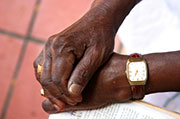
FRIDAY, Sept. 13 (HealthDay News) — U.S. nursing homes with a high proportion of black residents appear to deliver poorer care and perform worse financially than homes with no or few minority patients, a new study suggests.
In long-term care facilities without black residents, revenues and profit margins are higher, and health care outcomes seem to be better, according to the study of more than 11,000 U.S. nursing homes.
The two-tiered system is partly due to the fact that black residents rely on Medicaid — government-funded coverage for the poor — for long-term care more than others do, and reimbursement rates under Medicaid are lower than private pay or self-pay rates, the researchers noted.
But money doesn’t tell the whole story. “It isn’t only the financial performance [of nursing homes] that affects performance,” said Latarsha Chisholm, assistant professor at the University of Central Florida and lead author of the study published recently in Health Services Research. “There has to be something else affecting quality,” Chisholm said.
“I want to understand what management practices promote improved care in nursing homes with high proportions of minorities that don’t have disparities in care,” she added.
For the study, the researchers reviewed quality and financial data from 1999 to 2004 for about 11,500 freestanding Medicare- and Medicaid-certified nursing homes. Government facilities were excluded. Data were pulled from Medicare cost reports, so facilities without any Medicare beds were excluded. Financial data included operating profit margins, net income, revenue and operating costs adjusted for the number of patients per day.
Quality data included the ratio of nursing staff to patients, success in preventing pressure ulcers, help with walking and getting out of bed, prevention of urinary tract infections, and the incidence of medication errors, citations by governmental agencies and related factors.
The study found that nursing homes with a high proportion of black residents had lower costs, but also had lower revenues and tighter operating margins. Pressure ulcer prevention and help with walking were less common in nursing homes with a high proportion of black residents, while quality-of-care deficiencies and deficiency citations were more common.
While the research shows that black patients are at greater risk of being in nursing homes with lower financial performance and a lower quality of care, the authors noted that they were not able to show a cause-and-effect relationship between racial composition and nursing home performance.
Greg Crist, senior vice president of public affairs for the American Health Care Association, which represents the nursing home industry, said skilled nursing care centers are committed to quality care for everyone, regardless of ethnicity. “We remain focused on ensuring person-centered care for each individual’s unique needs, even despite chronic Medicaid underfunding,” he added.
One expert believes the study simply confirms what has been known for a long time. “There is an association between a high proportion of black residents and a facility being of low quality,” said Helena Temkin-Greener, a professor in the department of public health sciences at the University of Rochester School of Medicine in New York.
On a positive note, Temkin-Greener added that studies have found that within facilities there aren’t apparent differences in how black or white residents are treated. “That seems to suggest that it’s not biases in the attitudes of health care workers in treating people who look different, but something about the facility, and perhaps where you are located,” she said.
“Many years ago we talked about lack of access of African Americans to nursing homes, and we no longer are saying that,” said Temkin-Greener. “Maybe, reflecting on the larger society, whites are moving to assisted-living and blacks are going to nursing homes. Maybe blacks are financially and geographically constrained as well, but I don’t think it’s a reflection of the entire nursing home industry. It’s an issue of having anyone concentrated disproportionately in a certain type of facility.”
More information
Learn more about nursing homes from the U.S. National Library of Medicine.
Copyright © 2025 HealthDay. All rights reserved.

